A History of Football Kit Design in England and Scotland
(7) All Change Please! 1970-1979
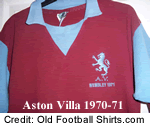 The novel flappy collar with V inset very quickly caught on throughout England and
The novel flappy collar with V inset very quickly caught on throughout England and 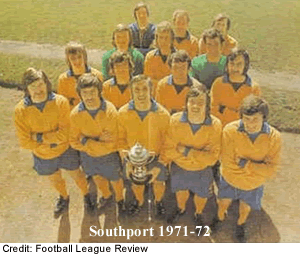 Scotland. After finishing the 1969-70 season wearing old, crew neck shirts, Aston Villa brought back their traditional light blue sleeves (and white shorts) for 1970-71 kit but retained the collar. Southport, a club not exactly overburdened with success, won the 1971-72 Fourth Division Championship, their one and only senior honour, wearing new
Scotland. After finishing the 1969-70 season wearing old, crew neck shirts, Aston Villa brought back their traditional light blue sleeves (and white shorts) for 1970-71 kit but retained the collar. Southport, a club not exactly overburdened with success, won the 1971-72 Fourth Division Championship, their one and only senior honour, wearing new 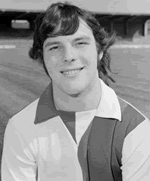 colours of old gold and blue with collars. Blackburn Rovers, whose iconic halved shirts had featured contrasting collar and cuff details since the mid-1950s, updated their tops with the latest fashion.
colours of old gold and blue with collars. Blackburn Rovers, whose iconic halved shirts had featured contrasting collar and cuff details since the mid-1950s, updated their tops with the latest fashion.
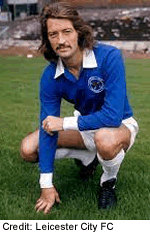 Within a few years new styles started to appear such as the buttoned collar favoured by Leicester City (right) and the collar and V neck combination worn by Notts County among others (below left).
Within a few years new styles started to appear such as the buttoned collar favoured by Leicester City (right) and the collar and V neck combination worn by Notts County among others (below left).
After the dull orthodoxy of the Sixties, clubs were beginning to demand more distinctive kits. Standard designs might have been widely available 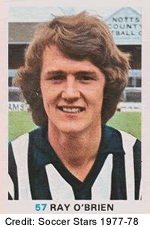 and reasonably inexpensive but it's not much cop if lots of other teams in your league are wearing the same strip as you are. For example, in 1965-66 ten sides in the Football League wore strips that were virtually identical to to that of Manchester United.
and reasonably inexpensive but it's not much cop if lots of other teams in your league are wearing the same strip as you are. For example, in 1965-66 ten sides in the Football League wore strips that were virtually identical to to that of Manchester United.
There is a long history in football of lesser teams adopting the colours of more successful sides in order to inspire their players and supporters. 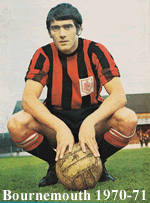 Think of all the teams that copied Aston Villa's iconic jerseys in the first half of the 20th century or Don Revie having Leeds United play in all-white to emulate Real Madrid. In 1970 John Bond, manager of Bournemouth & Boscombe Athletic, changed the team colours to red and black stripes modelled on AC Milan.
Think of all the teams that copied Aston Villa's iconic jerseys in the first half of the 20th century or Don Revie having Leeds United play in all-white to emulate Real Madrid. In 1970 John Bond, manager of Bournemouth & Boscombe Athletic, changed the team colours to red and black stripes modelled on AC Milan.
Birmingham City introduced their much-loved "penguin strip" in 1971 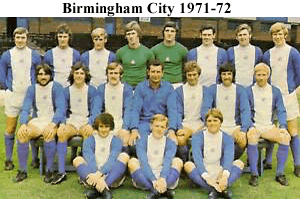 as a replacement for the "Chelsea-lite" outfits worn since 1965. Inspired by the iconic Ajax jerseys worn by Johan Cruyff and his team mates when they won the European Cup at Wembley earlier in the summer, the new look was an instant hit with supporters and players alike. A red and white version was used as a change strip. With millions of people now tuning in to the BBC's Match of the Day highlights programme and the regional ITV equivalents, Birmingham were instantly recognisable at a
as a replacement for the "Chelsea-lite" outfits worn since 1965. Inspired by the iconic Ajax jerseys worn by Johan Cruyff and his team mates when they won the European Cup at Wembley earlier in the summer, the new look was an instant hit with supporters and players alike. A red and white version was used as a change strip. With millions of people now tuning in to the BBC's Match of the Day highlights programme and the regional ITV equivalents, Birmingham were instantly recognisable at a 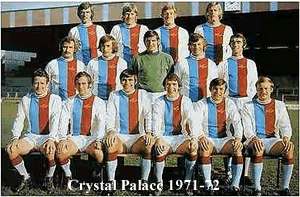 time when the vast majority of the public were still watching in black and white.
time when the vast majority of the public were still watching in black and white.
The Ajax influence is also evident in the Crystal Palace strip from the same season. In this instance the broad stripe is split into the then traditional club colours with claret and white trim at collar and cuff. Palace have worn many fine and distinctive kits in their time but this one is rightly considered a classic.
When unfashionable Carlisle United made it into the First 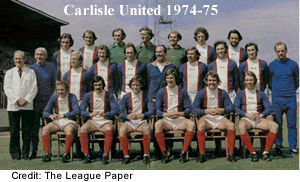 Division in 1974 they wore their own version, very similar to Birmingham's but with the addition of a red border to the central strip as well as red socks.
Division in 1974 they wore their own version, very similar to Birmingham's but with the addition of a red border to the central strip as well as red socks.
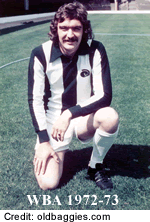 Throughout the 1960s West Bromwich Albion's navy and white striped shirts had plain white sleeves giving the team a very elegant look. After a decade it was time to update the strip to something more modern. The broad stripes chosen proved to be another design classic that was worn for ten years.
Throughout the 1960s West Bromwich Albion's navy and white striped shirts had plain white sleeves giving the team a very elegant look. After a decade it was time to update the strip to something more modern. The broad stripes chosen proved to be another design classic that was worn for ten years.
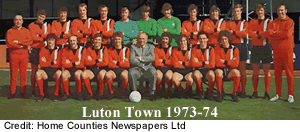 A few clubs went all-in when modernising their playing strip. Luton Town, who had played in sober white shirts and black shorts since 1920, went for entirely new colours of orange and navy blue with a navy and white vertical stripe down the left side of the shirts. York City, who had reverted to their original maroon and white colours in 1969, added a bold "Y" to their shirts in 1974-
A few clubs went all-in when modernising their playing strip. Luton Town, who had played in sober white shirts and black shorts since 1920, went for entirely new colours of orange and navy blue with a navy and white vertical stripe down the left side of the shirts. York City, who had reverted to their original maroon and white colours in 1969, added a bold "Y" to their shirts in 1974-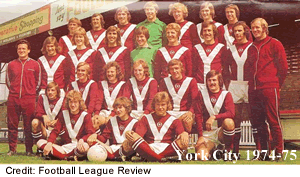 75 giving rise to a new nickname, The Y-Fronts.
75 giving rise to a new nickname, The Y-Fronts.
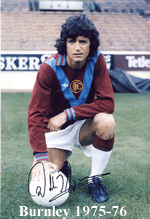 In 1969 Burnley had dropped their traditional light blue sleeves and played in plain claret tops with light blue crew necks and cuffs. In 1975 they made an even more radical change, adding a dramatic V to their plain claret shirts, striped collars and a monogram picked out in gold in the centre of their new shirts.
In 1969 Burnley had dropped their traditional light blue sleeves and played in plain claret tops with light blue crew necks and cuffs. In 1975 they made an even more radical change, adding a dramatic V to their plain claret shirts, striped collars and a monogram picked out in gold in the centre of their new shirts.
Several clubs who had modernised their appearance in the Sixties now returned to tradition. Supporters were thrilled 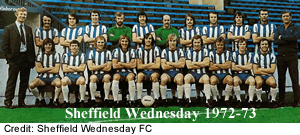 when Sheffield Wednesday dropped their blue shirts with white sleeves (colours associated more with Ipswich Town) and returned to the blue and white stripes that they had worn since time immemorial but now with a modern touch of blue shorts rather than the black they had
when Sheffield Wednesday dropped their blue shirts with white sleeves (colours associated more with Ipswich Town) and returned to the blue and white stripes that they had worn since time immemorial but now with a modern touch of blue shorts rather than the black they had 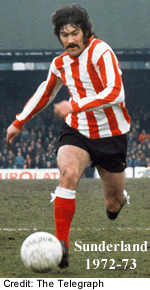 worn historically.
worn historically.
Sunderland, who had played in white shorts since 1961 also reverted to tradition, reinstating black shorts in 1972. The change was an auspicious one. The Wearsiders, then in the Second Division, beat Leeds United, the holders, in the 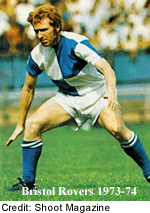 1973 FA Cup final.
1973 FA Cup final.
In 1973-74 Bristol Rovers once again played in the traditional quartered shirts that made them immediately identifiable and which had been dropped more than a decade ago.
In the Fifties and Sixties around one third of the teams in the Football League wore badges or club crests on their shirts. The proportion seems to have declined somewhat in the late Sixties when cyphers and monograms became popular or shirts were left unadorned. During the Seventies, however, the growing desire to make team shirts more individual and 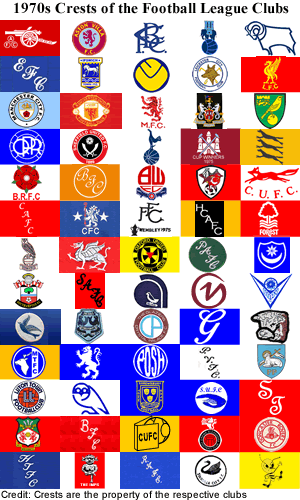 distinctive led to a dramatic increase in their use. Furthermore original club crest designs were now protected by copyright law and could be exploited commercially (even if no-one was really sure how to achieve this at the time). Since it was first published in 1970, Rothmans Football Yearbook, the bible for every fan, had included crests in the section devoted to individual clubs but when new designs were introduced these were not immediately featured due to concerns about copyright infringement.
distinctive led to a dramatic increase in their use. Furthermore original club crest designs were now protected by copyright law and could be exploited commercially (even if no-one was really sure how to achieve this at the time). Since it was first published in 1970, Rothmans Football Yearbook, the bible for every fan, had included crests in the section devoted to individual clubs but when new designs were introduced these were not immediately featured due to concerns about copyright infringement.
In 1975-76, two-thirds of the Football League teams sported crests on their shirts and a decade later only five teams, all of whom were financially hard-pressed, played in shirts with no badge at all.
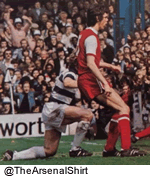 The Football League introduced a new regulation in 1975-76 requiring visiting teams to change their shorts if these clashed with those of the home side. (A similar requirement to change socks had been in place since 1968-69.) This was supposedly to make it easier for match officials to distinguish between teams, it being a well-known fact on the terraces that all referees and linesmen were partially sighted. This led to some curious anomolies such as Arsenal wearing red shorts in some away games, while Everton wore black shorts but later opted for blue. Manchester United added black shorts to the kit hamper and continue to get these out when necessary to this day. Teams who considered their first choice kits integral to the club's identity chose not to alter their iconic strips and wore their change kits instead: these include Leeds United, Liverpool and (after 1978), Arsenal.
The Football League introduced a new regulation in 1975-76 requiring visiting teams to change their shorts if these clashed with those of the home side. (A similar requirement to change socks had been in place since 1968-69.) This was supposedly to make it easier for match officials to distinguish between teams, it being a well-known fact on the terraces that all referees and linesmen were partially sighted. This led to some curious anomolies such as Arsenal wearing red shorts in some away games, while Everton wore black shorts but later opted for blue. Manchester United added black shorts to the kit hamper and continue to get these out when necessary to this day. Teams who considered their first choice kits integral to the club's identity chose not to alter their iconic strips and wore their change kits instead: these include Leeds United, Liverpool and (after 1978), Arsenal.
The Admiral Revolution
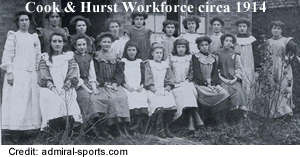 No examination of the decade woud be complete without considering the extraordinary impact of a small Leicestershire based sportswear company that radically changed football kit design and kick started what would become a multi-billion pound global market for replicas.
No examination of the decade woud be complete without considering the extraordinary impact of a small Leicestershire based sportswear company that radically changed football kit design and kick started what would become a multi-billion pound global market for replicas.
From modest beginnings in 1908 manufacturing woollen underwear as Cook & Hurst Ltd, the company expanded during the First World War when they supplied underwear to the armed forces and exercise clothing for the Royal Navy, which 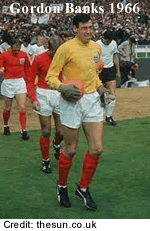 led to the name "Admiral." During the Second World War Admiral supplied British and American armed forces with sportswear. In 1958 Bert Patrick bought the company for £34,000 (the equivalent of £640,000 at today's prices).
led to the name "Admiral." During the Second World War Admiral supplied British and American armed forces with sportswear. In 1958 Bert Patrick bought the company for £34,000 (the equivalent of £640,000 at today's prices).
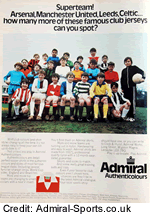 Admiral provided the jerseys worn by Gordon Banks in the 1966 World Cup after which Patrick conceived the idea of moving into the football kit market and creating replicas in juvenile sizes. Umbro had tried to pursue the same concept in the late Fifties and Sixties with their Umbrosets but sales had been modest. This also seems to have been the case with the company's first marketing attempt from 1972-73 for "Admiral Authenticolours." (Scaleable image - click for larger view.)
Admiral provided the jerseys worn by Gordon Banks in the 1966 World Cup after which Patrick conceived the idea of moving into the football kit market and creating replicas in juvenile sizes. Umbro had tried to pursue the same concept in the late Fifties and Sixties with their Umbrosets but sales had been modest. This also seems to have been the case with the company's first marketing attempt from 1972-73 for "Admiral Authenticolours." (Scaleable image - click for larger view.)
A chance encounter in 1973 between Patrick and Don Revie at the Leeds United training ground proved to be the turning point. Patrick proposed that his company would redesign the Leeds kit and exclusively market replicas of the new design to kids. Leeds would receive a royalty payment on each unit sold. Revie, a man always looking for ways to pick up a bit of brass, told Patrick that the team's white kit was off-limits but he was welcome to design a new 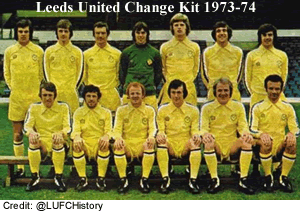 change kit and all Admiral would have to pay for the privilege would be £7,000 (£68,000 at 2022 prices), funds that went straight into the players' pool.
change kit and all Admiral would have to pay for the privilege would be £7,000 (£68,000 at 2022 prices), funds that went straight into the players' pool.
The result was sublime: an all-yellow strip with a large, self-coloured buttoned collar and blue and white trim on the shoulders and sleeves, the sides of the shorts and the stocking turnovers. The colours gave a nod to the club's history while the trimmings had never been seen before. Furthermore, the Admiral logo appeared prominently, proclaiming that this was not only a Leeds United kit but also one made by Admiral.
To maximise exposure, the team wore the yellow strip in all of their away matches (giving rise to the misnomer of an "away kit"). The Admiral brand also appeared on Leeds' 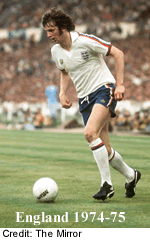 white kit and the company supplied heavily branded tracksuits, sports bags and anything else that might gain exposure on the pitch.
white kit and the company supplied heavily branded tracksuits, sports bags and anything else that might gain exposure on the pitch.
Key to Admiral's strategy was to protect their original designs under the 1968 Design Copyright Act which prevented their rivals from making copies.
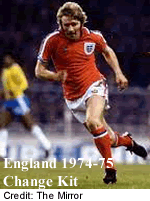 After England failed to qualify for the 1974 World Cup, the FA sacked the manager, Alf Ramsey, and appointed Don Revie in his place. Before the appointment was made public, Revie telephoned Bert Patrick to tell him that he wanted Admiral to redesign the national team's kits and set up a commercial arrangement with the Football Association.
After England failed to qualify for the 1974 World Cup, the FA sacked the manager, Alf Ramsey, and appointed Don Revie in his place. Before the appointment was made public, Revie telephoned Bert Patrick to tell him that he wanted Admiral to redesign the national team's kits and set up a commercial arrangement with the Football Association.
Under the landmark deal that emerged, Admiral would pay the FA £15,000 a year (£125,000 at 2022 prices) or a 10% royalty, whichever was higher. This was the first time that a national football association had entered into a commercial sponsorship arrangement and the first time that the national team's kit had been available for the public to buy (albeit in junior sizes). The new kits did not go down well with traditionalists but then they were not Admiral's target demographic.
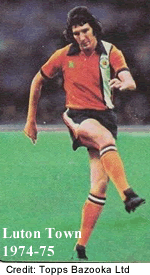 In 1974-75 Luton Town joined the Admiral camp. Their recently adopted orange, navy and white strip, was transformed from a quirky outlier into an object of real beauty that is to this day considered a classic.
In 1974-75 Luton Town joined the Admiral camp. Their recently adopted orange, navy and white strip, was transformed from a quirky outlier into an object of real beauty that is to this day considered a classic.
Patrick's strategy was now to target 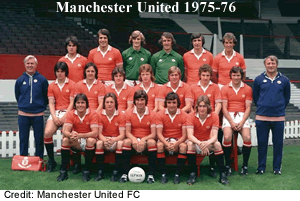 the top teams in the First Division, starting with Manchester United who played in Admiral for the first time in 1975-76. By the company's standards this was quite conservative, the key feature being a novel collar. It is also noticeable that for the first five months of the season the Admiral logo did not appear on the shirts.
the top teams in the First Division, starting with Manchester United who played in Admiral for the first time in 1975-76. By the company's standards this was quite conservative, the key feature being a novel collar. It is also noticeable that for the first five months of the season the Admiral logo did not appear on the shirts.
The 1975-76 Sheffield United strip re-imagined their traditional red and white stripes by adding black edging. 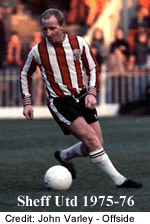 All of the new designs were accompanied by equally striking change kits.
All of the new designs were accompanied by equally striking change kits.
Key to Admiral's success was their chief designer, Debbie Jackson, She had no knowledge whatsoever of football but understood fashion and design which allowed her to approach her job with completely fresh eyes. Her ideas were novel, bold, original and exciting. Clubs were queuing up for the Admiral treatment and, with the sponsorship money generally benefitting members of the team, players were eager to play in Admiral gear.
Colour television was another factor in Admiral's success. By the mid-Seventies these had become more affordable and an increasing number of households now had 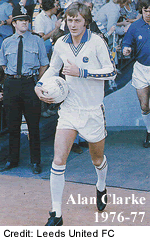 a set. Admiral's bold, colourful designs looked good on TV and stood out from the more conservative designs of their competitors. They also reflected the fashion of the period for flamboyant clothing (kipper ties, flared trousers, huge collars, platform shoes etc) in bold colours. They were decidedly modern.
a set. Admiral's bold, colourful designs looked good on TV and stood out from the more conservative designs of their competitors. They also reflected the fashion of the period for flamboyant clothing (kipper ties, flared trousers, huge collars, platform shoes etc) in bold colours. They were decidedly modern.
In 1976-77, impressed with sales of the team's yellow kit, Leeds United invited Admiral to redesign their all-white strip. The sportswear company took things to a 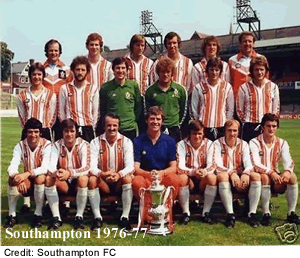 new level with a flamboyant reinvention of the team's kit featuring a bold new collar in blue and yellow and tapes down the sleeves, shorts and sock turnovers that carried the Admiral brand.
new level with a flamboyant reinvention of the team's kit featuring a bold new collar in blue and yellow and tapes down the sleeves, shorts and sock turnovers that carried the Admiral brand.
When Second Division Southampton unexpectedly beat Manchester United in the 1976 FA Cup final, they wore a yellow and blue Admiral kit based on the new Leeds template. The following 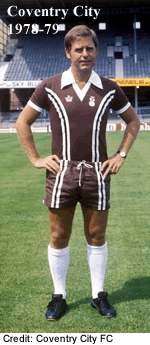 season they took the field in a radically new first choice strip with irregular stripes.
season they took the field in a radically new first choice strip with irregular stripes.
One of Jackson's most popular and original designs was the "Tramline Kit" worn by Coventry City, Dundee, and Wales. The version shown here is, and lets not mince words, City's infamous "turd strip" from 1978-79. Considered for many years to have been one of the 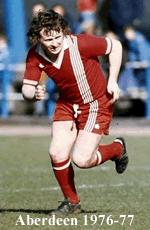 worst kits of all time, this has become a treasured icon of Coventry's kit heritage and original versions exchange hands for hundreds of pounds.
worst kits of all time, this has become a treasured icon of Coventry's kit heritage and original versions exchange hands for hundreds of pounds.
In Scotland, Aberdeen, Dundee, Motherwell, Clydebank and Kilmarnock were among the teams that jumped aboard the Admiral bandwagon.
In 1976 West Ham United reached the final of the European Cup Winners' Cup and, true to form, Admiral were on the telephone immediately with an offer. This was a big ask at the time: the Hammers elegant shirts, worn since 1960 were iconic and associated with West Ham's three 1966 World Cup heroes. Nevertheless, when the t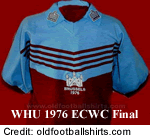 eam walked out at Heysel Stadium, they were wearing brand new and unique jerseys. Although they lost on the night the new kit was a huge success and was kept until 1980.
eam walked out at Heysel Stadium, they were wearing brand new and unique jerseys. Although they lost on the night the new kit was a huge success and was kept until 1980.
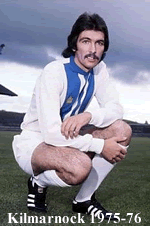 From time immemorial Umbro and Bukta had supplied most if not all of the Football League clubs but within a few years of launching their yellow Leeds strip, Admiral had outstripped Bukta and were challenging Umbro to become the leading supplier.
From time immemorial Umbro and Bukta had supplied most if not all of the Football League clubs but within a few years of launching their yellow Leeds strip, Admiral had outstripped Bukta and were challenging Umbro to become the leading supplier.
School playgrounds across the UK were now filled with boys (and it was almost exclusively the boys) kicking footballs about while wearing the latest outfit as worn by their heroes. Shoot magazine, the most popular football weekly that was aimed firmly at the juvenile market, contained portraits of star players, team photographs and advertisements for Admiral gear that could be pinned to the 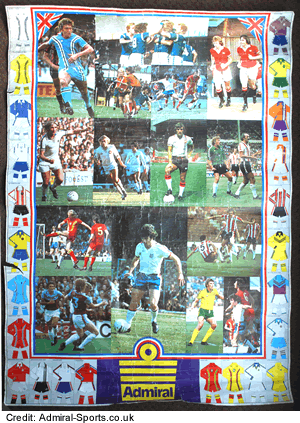 bedroom wall. At one stage you could write to the magazine to receive a free wall poster (left - image is scaleable) with graphics of the latest Admiral kits and photographs of star players wearing them. Not only were Admiral's designs way ahead of the competition, their marketing strategy was too.
bedroom wall. At one stage you could write to the magazine to receive a free wall poster (left - image is scaleable) with graphics of the latest Admiral kits and photographs of star players wearing them. Not only were Admiral's designs way ahead of the competition, their marketing strategy was too.
In 1975 the New York Cosmos signed Pele creating a media sensation and generating huge interest in the North American Soccer League (NASL). More high-profile European stars, nearing the end of their playing careers followed including 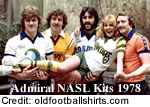 George Best, Johann Cruyff and Wim Janssen. Shoot magazine had regular coverage of the league raising its exposure among UK youngsters. Seeing the opportunity to expand into a new market, Admiral signed contracts with a number of NASL teams and soon replica shirts from the Cosmos, Tampa Bay Rowdies, the LA Aztecs and others were appearing on the shelves in the UK.
George Best, Johann Cruyff and Wim Janssen. Shoot magazine had regular coverage of the league raising its exposure among UK youngsters. Seeing the opportunity to expand into a new market, Admiral signed contracts with a number of NASL teams and soon replica shirts from the Cosmos, Tampa Bay Rowdies, the LA Aztecs and others were appearing on the shelves in the UK.
Design flair and effective marketing were Admiral's strengths but product quality was most definitely a weakness. Kits produced for professional teams were manufactured from good quality fabric with stitched crests. The replicas, however, were made from cheap nylon with heat-applied plastic transfers that broke up in the wash. This might not have been of too much concern in the playground but it would be an issue if replica kit sales were to expand into the adult market in the future.
The Empire Strikes Back
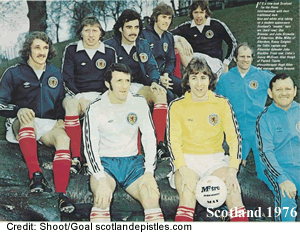 It did not take long for the big beasts of UK sportswear manufacturing to respond to the upstarts from Leicestershire. Umbro's double diamond logo had featured on their products since 1973 but in 1976 they followed Admiral's lead by introducing contrasting tapes that featured a diamond motif. Kitting out the Scottish national team in the new design was a
It did not take long for the big beasts of UK sportswear manufacturing to respond to the upstarts from Leicestershire. Umbro's double diamond logo had featured on their products since 1973 but in 1976 they followed Admiral's lead by introducing contrasting tapes that featured a diamond motif. Kitting out the Scottish national team in the new design was a 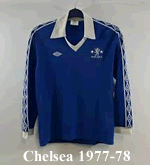 considerable coup for the Manchester company who also signed deals with Everton, Derby County, Bristol City and Manchester City.
considerable coup for the Manchester company who also signed deals with Everton, Derby County, Bristol City and Manchester City.
The following season Umbro refined their design, replacing the solid diamonds with their trademark double diamond. In addition, that Christmas advertisements appeared promoting "Umbrosets for Boys" (not for girls of course - this 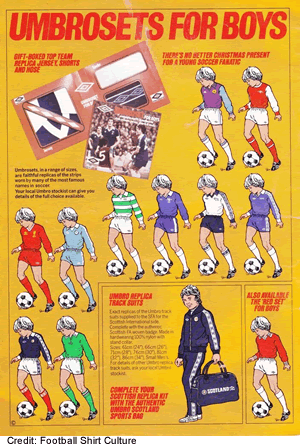 was the Seventies), announcing that Umbro were going after the lucrative kids' market. A glance at the relevant page from the Umbro catalogue illustrates what an impressive portfolio of top level clubs Umbro had under their wing at the time.
was the Seventies), announcing that Umbro were going after the lucrative kids' market. A glance at the relevant page from the Umbro catalogue illustrates what an impressive portfolio of top level clubs Umbro had under their wing at the time.
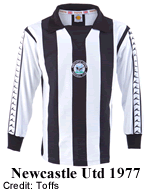 Bukta had a less impressive roster with only Middlesbrough and Newcastle United wearing their products in the English top flight in 1976-77. They had followed their rivals by introducing tapes that featured their trademark flying buck in 1977 and these stood out well on Newcastle's shirt which, for the first time featured white sleeves. In Scotland the company achieved something of a coup by having not only their branding down the sleeves of Hibernian's famous green and white jersey but
Bukta had a less impressive roster with only Middlesbrough and Newcastle United wearing their products in the English top flight in 1976-77. They had followed their rivals by introducing tapes that featured their trademark flying buck in 1977 and these stood out well on Newcastle's shirt which, for the first time featured white sleeves. In Scotland the company achieved something of a coup by having not only their branding down the sleeves of Hibernian's famous green and white jersey but 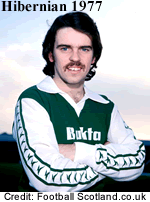 also their name plastered across the front. This was the first time that a club in the UK had featured the name of their sponsor on their shirts. The TV companies refused to televise matches in which the logotype appeared so Hibs had to wear tops without the Bukta name when cameras were present.
also their name plastered across the front. This was the first time that a club in the UK had featured the name of their sponsor on their shirts. The TV companies refused to televise matches in which the logotype appeared so Hibs had to wear tops without the Bukta name when cameras were present.
With fewer prominent teams wearing their kit compared to their competitors, Bukta focussed on promoting their products to their traditional market - football clubs at all levels, schools and colleges - rather than the emerging replica market.
In the early Seventies the German sportswear company, Adidas, began to move into the football kit market in Europe. The company had built a strong reputation through the sales of football boots and other equipment across a range of sports. By the middle of the decade Adidas' signature three-stripe trim and trefoil logo were a common sight across Europe and the company turned its attention to England. Umbro had a long standing arrangement with the German company under which they would promote Adidas' footwear and other products to their clients. Adidas now suggested that they should like to approach some of Umbro's clients as well as 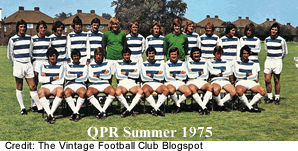 other clubs in England to sell their range of football attire. It was like inviting a tiger to tea (and not in a good way).
other clubs in England to sell their range of football attire. It was like inviting a tiger to tea (and not in a good way).
In the summer of 1975 the Queen's Park Rangers team was photographed wearing Adidas shirts. This caused a bit of a stir but when the new season started, the team were wearing Umbro as usual. It seems possble the picture was taken to gauge the reaction of fans before committing to a deal. In any event come August 1976 Rangers turned out in a standard Adidas hooped shirt which was replaced a month later when the more familiar broad hoop version was delivered. Rangers stayed with Adidas until 1989.
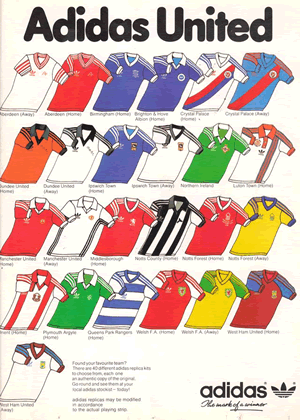 In 1977-78 Adidas signed up more clubs in England and Scotland, including Ipswich Town, Orient, Crystal Palace, Notts County, Middlesbrough, Birmingham City, Dundee United. By the end of the decade they were a major player in both the English and Scottish professional leagues.
In 1977-78 Adidas signed up more clubs in England and Scotland, including Ipswich Town, Orient, Crystal Palace, Notts County, Middlesbrough, Birmingham City, Dundee United. By the end of the decade they were a major player in both the English and Scottish professional leagues.
The rise of Adidas coincided with the decline of Admiral and the advertisement on the right illustrates just how many teams associated with the Leicestershire company defected to Adidas in the final years of the decade.
There are several reasons behind this. Despite its astonishing success, Admiral remained a modest, privately owned textile company with a seriously flawed business model. Now that the replica kit market had taken off clubs demanded ever larger sponsorship fees and without significant outside investment, these were becoming unaffordable. Furthermore Admiral were signing up small clubs in the lower tiers, such as Forfar Athletic, Arbroath, Bradford City and Hereford United, whose following was so small that they would never generate significant replica sales. Admiral had also overeached: a failed attempt to set up a manufacturing base in Germany had cost the company £250,000 (£1.6m in 2022 prices) and it was only the lucrative contract with the FA to supply kit to the national team that was keeping the company afloat. Indeed, in June 1980 the money ran out and the bank called in the receivers.
By way of contrast, with its enormous and diverse product range, global presence and huge financial resources, Adidas had far deeper pockets than anyone else in the market.
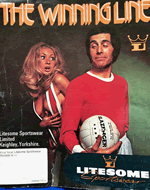 Another factor was changing taste. Admiral's designs, so cool and exciting in the mid Seventies, were looking decidedly tired by the end of the decade. The kids who had eagerly kicked a football around the playground wearing their favourite team strip were now young adults whose
Another factor was changing taste. Admiral's designs, so cool and exciting in the mid Seventies, were looking decidedly tired by the end of the decade. The kids who had eagerly kicked a football around the playground wearing their favourite team strip were now young adults whose 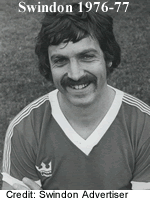 interest was in cool clothing brands like Lacoste, Benetton, Gucci, Tommy Hilfiger, Fred Perry and the rest. Adidas were heavily identified with the emerging leisure sports market and their apparel was constantly seen on TV being worn by elite athletes. The Adidas brand was seriously cool and far more acceptable as street wear than a 1976 replica football shirt.
interest was in cool clothing brands like Lacoste, Benetton, Gucci, Tommy Hilfiger, Fred Perry and the rest. Adidas were heavily identified with the emerging leisure sports market and their apparel was constantly seen on TV being worn by elite athletes. The Adidas brand was seriously cool and far more acceptable as street wear than a 1976 replica football shirt.
A handful of new suppliers appeared including Litesome who were based in Yorkshire and were not averse to using a bit of smut to promote their products (this was the Seventies after all). Their signature look was an Adidas rip-off, substituting four narrow lines for the German company's three stripe trim to avoid copyright problems. The firm had a long-standing relationship 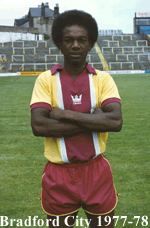 with Bradford City for whom they produced several original designs until 1982. Their core business was to sell kit sets to local clubs, schools and youth teams which I can say from personal experience were made from the cheapest nylon fabric available. The company is now dormant.
with Bradford City for whom they produced several original designs until 1982. Their core business was to sell kit sets to local clubs, schools and youth teams which I can say from personal experience were made from the cheapest nylon fabric available. The company is now dormant.
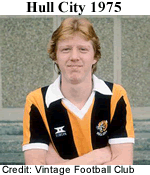 Europa Sportswear was formed in 1974 when two sock manufacturers from Leicester merged with Arco Sports, who were based in Hull. The new company struck a deal with their local side Hull City and provided their kit from 1975 until 1980. Their design reimagined the Tigers' traditional striped shirt and for the first time ever, introduced white to their colour pallette. Europa did not supply anyone else and rather focussed on selling sportswear to the general public. They claim to be one of the leading suppliers in the Back to School sector.
Europa Sportswear was formed in 1974 when two sock manufacturers from Leicester merged with Arco Sports, who were based in Hull. The new company struck a deal with their local side Hull City and provided their kit from 1975 until 1980. Their design reimagined the Tigers' traditional striped shirt and for the first time ever, introduced white to their colour pallette. Europa did not supply anyone else and rather focussed on selling sportswear to the general public. They claim to be one of the leading suppliers in the Back to School sector.
And Finally - A Word From Our Sponsor
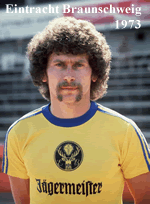 Towards the end of the 1970s there was increasing pressure on
clubs to feature sponsors' logos on player’s shirts. With inflation high and gate receipts falling, clubs were desperate to find new revenue streams. Characteristically the football authorities refused to consider the idea.
Towards the end of the 1970s there was increasing pressure on
clubs to feature sponsors' logos on player’s shirts. With inflation high and gate receipts falling, clubs were desperate to find new revenue streams. Characteristically the football authorities refused to consider the idea.
The first ever sponsorship deal involved West German team, Eintracht Braunschweig who wore the Jägermeister logo type on their shirts in 1973.
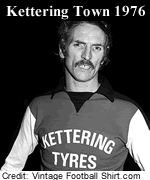 The first shirt sponsorship deal among the UK's senior clubs was brokered by former Wolves striker Derek Dougan, who joined Kettering Town, then in the Southern League, as chief executive after he retired from playing. He brokered a deal with a local company, Kettering Tyres, whose name appeared on the players' shirts in a match against Bath City on January 24 1976. Four days later the Football Association ordered the sponsorship be removed.
Dougan removed only the final letters, changing the wording on the shirts to "Kettering T" and claimed this was nothing to do with their sponsors but simply the name of the club. In April 1976 the FA, none of whom were born yesterday, ordered the wording removed under the threat of a £1,000 fine (£6,500 in today's money).
The first shirt sponsorship deal among the UK's senior clubs was brokered by former Wolves striker Derek Dougan, who joined Kettering Town, then in the Southern League, as chief executive after he retired from playing. He brokered a deal with a local company, Kettering Tyres, whose name appeared on the players' shirts in a match against Bath City on January 24 1976. Four days later the Football Association ordered the sponsorship be removed.
Dougan removed only the final letters, changing the wording on the shirts to "Kettering T" and claimed this was nothing to do with their sponsors but simply the name of the club. In April 1976 the FA, none of whom were born yesterday, ordered the wording removed under the threat of a £1,000 fine (£6,500 in today's money).
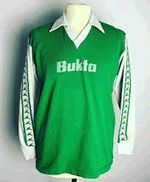 Kettering, along with Derby County and Bolton Wanderers then submitted a proposal to the FA to allow shirt sponsorship, which was accepted on June 3 1977. Ironically Kettering were unable to find a sponsor for the following season.
Kettering, along with Derby County and Bolton Wanderers then submitted a proposal to the FA to allow shirt sponsorship, which was accepted on June 3 1977. Ironically Kettering were unable to find a sponsor for the following season.
In 1977 Hibernian, who as a Scottish team were beyond the jurisdiction of the Football Association and the Football League, became the first top-level UK club to wear shirts carrying sponsorship (by Bukta, the kit manufacturer).
Derby County landed the first English deal
with Saab in 1978 but this fell through 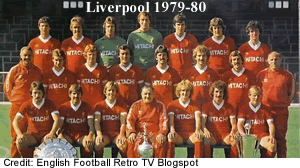 after the pre-season
photo shoot and did not go into production.
after the pre-season
photo shoot and did not go into production.
It fell to Liverpool a year later to wear the first shirts to carry a sponsor’s name in the Football League in 1979-80. The deal with the Japanese electronics firm Hitachi was worth £50,000 a year (£256,000 in 2023 value) and ran for three years.
Initially the BBC and ITV companies refused to televise matches in which shirt sponsorship was involved so teams had to keep a plain set in the kit hamper.
© Dave Moor (2023)